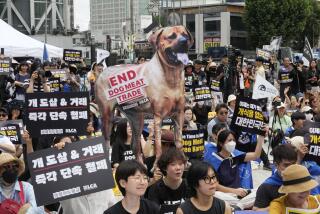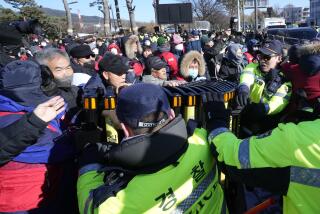In S. Korea, Call It ‘Meat the Press’
- Share via
KIMPO COUNTY, South Korea — In this county bordering the southern edge of the tense Demilitarized Zone, residents yearn to help reunify North and South Korea--and their starry-eyed dreams aren’t based on a bunch of bull.
They’re based on one bull.
South Korean marines rescued the hapless beast Friday from the bleak DMZ, where it faced certain death from starvation after being washed there by northern floods last year.
To Kimpo County official Yu Jong Bok, the presence of the bedraggled beast from the North in this, the Year of the Bull, seemed a divine sign that his rural county is destined for some larger mission. He hopes the beast will become a symbol of reunification and spark public education on how to heal the divided nation.
“We will name it the ‘Bull of Peace,’ ” Yu declared before a jostling crowd of 60 journalists who had trooped to the grim no man’s land for the biggest media spectacle Kimpo had ever seen.
He said officials will take the bull to a farm--to be renamed “Peace Farm”--where southern families separated from their northern relatives during the Korean War and sealed off from them ever since will care for it.
Yu noted that he had shelved his original idea to request a cow from North Korea to allow the pair to live in harmony as a fitting symbol of reunification.
Except for a lame and swollen front hoof, the bull appeared fine, if dazed by all the commotion. A local veterinarian pronounced it “a bit skinny” at about 800 pounds and immediately injected it with a syringe of liquid nutrition.
Marine sentries first sighted the bull in August roaming uninhabited Yudo Island in the DMZ. A second bull was also seen but died, presumably from starvation. After Yu heard about the beast, he petitioned the South Korean Defense Ministry, Unification Ministry and Korean Animal Protection Assn. to craft a rescue plan.
North Korea was notified Thursday by the U.N. Command that southern soldiers intended to enter the DMZ but did not respond, officials said.
The rescue was launched early Friday with all the trappings of a crack military operation. Marines in camouflage fatigues and greasepaint, along with a few frogmen, boarded three rubber boats for Yudo Island. The island, the site of heavy fighting in the 1950s, was once occupied by three families but is now known mainly for snakes and cranes.
In a briefing explaining the operation, complete with a four-color diagram, military spokesman Cho In Keun told journalists that marines would land first and sweep the area of mines. Then a veterinarian would shoot the bull with sedatives--a detail that provoked spirited protests from photographers, who argued that a dazed bull lying on its side would not make good art.
“Sorry, it can’t be helped,” Cho said briskly.
While journalists were kept at a DMZ lookout point, the rescue team went in. After two hours or so, they brought the bull out in a rubber boat. And when it was finally hauled up to meet the media, pandemonium erupted.
Journalists clambered atop the truck where the bull was tied down on its side and jostled for position to record the moment.
“Come here and touch the bull’s wounded leg!” one cameraman yelled to the vet. He obliged, pulling out a stethoscope, duly patting the bovine’s back and even shoving an electric prod into its rump so television crews could catch the sound of its bellow.
A rescue team member said the bull was seen eating grass about 50 feet from shore when the team approached. “We didn’t carry any weapons other than minesweepers and didn’t know what dangers there might be,” the marine said excitedly. “The bull was agitated when shot with sedatives, and it took him a while to fall on his side.”
County chief Yu and Lt. Col. Cho Gon Chul shook hands and exchanged an official document confirming the hand-over from military to civilian hands--repeating the ritual three times for the cameras.
And Lee Gon Han, a farmer from the nearby village of Wolgon, draped a golden bell around the bull, along with a fluorescent pink ribbon fringed in white lace and emblazoned with the words “Bull of Peace.”
More to Read
Sign up for Essential California
The most important California stories and recommendations in your inbox every morning.
You may occasionally receive promotional content from the Los Angeles Times.











